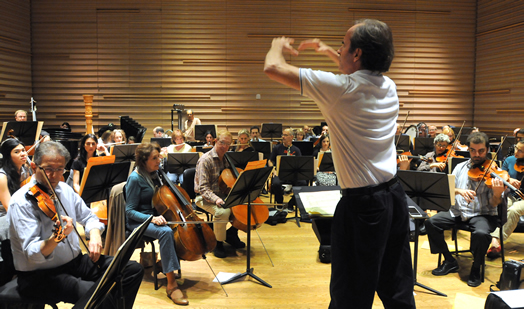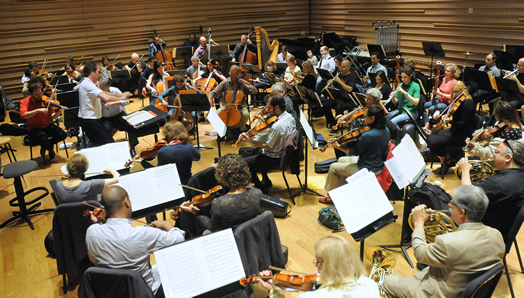Allegro
The American Ballet Theatre Celebrates 75 Years
Volume 115, No. 7July, 2015

Photos: Walter Karling
I joined ABT in the late 70s. It was not the coveted job that it is now. Orchestra members worked very hard to improve working conditions and salaries over the years, but that’s the kind of progress that’s been made on lots of orchestra jobs over the same years. What was so exciting in the 80s was the hold that ballet had over NYC in those years. The excitement was palpable, in part due to the defections from the Soviet Union of dancers like Mikhail Baryshnikov and others. Being able to watch these artists from the pit or in rehearsal – or even in their morning class when at the Met – was thrilling! (That also includes the American stars of ABT, not just the Russians.) Being a part of ABT made us feel we were part of an important artistic renaissance. And the shorter rep season at City Center was exciting as well for all the new and standard “short” ballets. The other rewarding experience is watching young 16-year-olds join the company and seeing their artistry mature over the years. Witnessing that process is exciting. Mingling in the cafeteria at the Met with your idols is not so shabby either. Working with the composer and conductor John Lanchbery was such a treat. As an orchestra, we are nothing if not flexible – adjusting to the styles of many dancers and conductors over the years. And as a mom, it is so gratifying to have witnessed the breaking of that “rule” that prima-ballerinas had to give up on having children. It started, I would say, in the 90s. Dancers in the company would take a short leave and return with a baby backstage. They were still every bit as wonderful as a dancer on stage. Our dancers Julie, Irina, Alessandra are mothers – just to name just a few. They are great artists who have broken the old model – and did it brilliantly. (The same is true of the dancers who are dads.) I am in awe of these artists. For me, seeing them up close when they come forward for their bows, is something I never get tired of.
– Olivia Koppell
I always looked forward to the moment in rehearsals with Maestro Lanchbery when he would say something like “I don’t think we’re quite getting it. It might help if I told you the story.” He would then impart a thought or two of his own invention that would touch on the story (and what stories!) of the ballet we were accompanying. I like to think it helped us to know a little about what was happening up there on the stage, but I can’t be sure. One morning Sherman Goldscheid brought to the rehearsal a rave review of the ABT written by Clive Barnes. At the break, he took it to the maestro. “Jack,” Sherman said, “you have to read this! Barnes says you are the best ballet conductor in the world!” For supporting evidence, Sherman had the review in front of him and seemed to offer it for the maestro’s perusal. The maestro not only averted his glance but seemed to push the review away from him as if it were something unclean. “I never read reviews,” he said. “A favorable review from a critic is like an executioner complimenting you on your neck.”
– Dave Wilson
I have been playing with ABT since 2000. My fondest memory must be from my first week there. I was fortunate enough to be asked to play bass clarinet in Prokofiev’s “Romeo and Juliet.” This was my first big job in NYC since returning back after three years studying in Paris and also my very first professional engagement playing bass clarinet. The chance to join this orchestra and play that incredible music was life changing. By now, I have been so lucky to have probably performed it close to 100 times. The score never gets old, it is never dull: it is amazing.
– David Gould

I began playing New York seasons during the 1970s at City Center. Fortunately for me, I sat on the outside rail and was able to catch occasional glimpses of high-flying dance masters. This was also the time that Mikhail Baryshnikov came to the U.S. What an amazing time. His skill was unique and a joy to see during curtain calls, bowing to the audience. Akira Endo was on the podium. He was a fine musician who communicated the stage requests clearly and kept the atmosphere happy. The orchestra players were well seasoned, fine musicians who knew the repertoire so well. The woodwind back row was Cy Segal, Fred Loeb, James Douglas and myself! My colleagues helped me speed along as each piece flew by. The tattered, dog-eared parts were hard to read. It was a challenge to be perfect. My colleagues were a great help, and we laughed a lot.
The seasons which followed were at the new Met Opera House at a time when it was a male-dominated business. It was hard to believe that the new opera house was built with an enormous locker room on the pit level – for men only. Finally they realized that we ladies needed one too! I believe there were only a couple of women in the Met orchestra and not too many in ours. As the Sol Hurok presentations increased at the Met, the Ladies Locker room began its development. Ah, how times have changed.
The size of the stage allowed for big beautiful sets for large full-length productions. Natalia Makarova choreographed as well as danced with scores arranged and conducted by John Lanchbery, a ballet guru. Lanchbery, a super fine musician, was responsible for so many scores we performed regularly, including “Giselle,” “Don Quixote,” and “La Bayadere,” to name a few. The company presented many large full-length productions with the new roster of great dancers. We performed with fabulous sets, lighting and costumes, and the roster then included Gregory, Van Hamel, Harvey, Jaffe, Baryshnikov, Bueones, McKenzie, Godinov, Nagy, Nureyev, to name a few. Lucia Chase, who co-founded the ABT, was also dancing. Excellent musicians in the pit delivered these scores with levels of perfection one strives for, the payoff of all our studying years. The audience enthusiasm was exciting. Crowds filled the house for every performance, applauding and cheering for multiple curtain calls. As we left the building, the crowd was still cheering. The excitement of live performances at Lincoln Center was at its peak.
Our great violin soloists included Israel Chorberg, David Nadien and Ronald Oakland. I’d also like to remember the conductor Ken Schemerhorn, a fine musician.
The more recent decades headed in new directions with stars like the dancer and choreographer Alicia Alonso. On the podium, we had Jack Everly, Charles Barker, David La Marche and our most recent music director Ormsby Wilkins.
I was happy to participate on several committees that brought me closer to dedicated colleagues. Frank Donoruma, Olivia Koppell, Karen Purpura, Fred Eckler, Tom Olcott, Virginia Benz and Lou Barranti gave their time for their fellow musicians and helped us win fair contracts. Negotiations were difficult but rewarding as they took place at Local 802 and at 890 Broadway with lawyers, managers and union officials, often well into the night.
It was a difficult decision to retire from work, but these experiences lasted over a period of more than 40 years.
I will miss the camaraderie of lifelong colleagues. I lift my glass and salute the company’s 75th year. Here’s to the next 75!
– Bernadette Zirkuli
